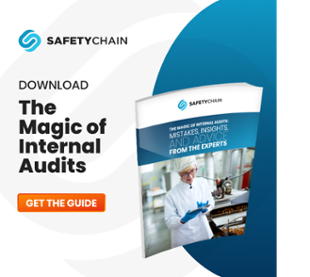Conducting an Effective Internal Audit for GFSI Standards
Completing an effective internal audit for GFSI standards is an important pillar of food safety compliance for many food and beverage companies, especially for retail and food service corporations. Within the last 15 years, internal audits have evolved from GMP-type checklists to encompass more comprehensive verification documentation. Here, we discuss some of the ways you can prepare for and conduct an effective internal audit for GFSI.
Planning the Audit
As you prepare for your audit, use the GFSI standard as guidance. Look at the entire food safety management system to ensure a thorough understanding of all the technical requirements. Because GFSI programs are large and cover many aspects of food safety, you should pace the audit to maximize effectiveness, and pre-arrange interviews with managers in advance. If possible, plan the internal audit out over the course of a year (this is a requirement of the BRC Food Standard).
GFSI Audit Requirement
The GFSI standard states that an organization’s internal audit system should “cover all activities within the scope of the Food Safety Management System.” Specific requirements vary by scheme. For example, while internal audits are required by Safe Quality Food (SQF) Standards, the BRC Global Standard for Food Safety Issue 8, and FSSC 22000:2018, each has its own unique benchmarks. It’s therefore important to go through each component carefully to ensure audits are being conducted precisely as required.
Techniques for Conducting the Audit
For each clause or sub-clause of the GFSI standard, read the requirement and ask: What do we need to measure? What is necessary to see/hear as a measure of compliance? Which records or documents need to be in place?
Next, develop a strategy for determining compliance. This may encompass the following activities:
Conducting interviews
Reviewing records, including a history of documented performance
Visual observation
Following audit trails
Observing all production shifts and testing backup personnel
Witnessing demonstrations of critical tasks
Using a “perch” to observe personnel movements and actions unseen
Following the process map to ensure accuracy
Trying to find gaps, imperfections, and anomalies
Verification & Documentation
An internal audit is an independent verification of compliance. It confirms that you’re doing what you’re saying within your facility. Of course, other verifications may be needed to support a robust food safety and quality assurance program, but the internal audit can be a very effective tool.
In terms of documentation, as the saying goes, it’s a good practice to “document everything.” Record your audit findings and address non-conformances during your review with management. No plant is perfect, but the objective is to create an atmosphere in which you can develop correct as quickly as possible. When documenting findings, clarify what was checked to make the determination of compliance or non-compliance. Be sure that any non-conformance is clearly stated and objective evidence is recorded.
Opening & Closing Meeting
The opening meeting should set expectations for the audit, introduce all auditors to management and supervisory teams, distribute the audit schedule, summarize techniques to be used, and detail the expectations for corrective meetings.
During the closing meeting, thank all participants and details all of the positive observations. Then, review non-conformances in detail and get commitment for reasonable completion dates. Follow-up to completion to ensure all items needing to be addressed have been resolved.



